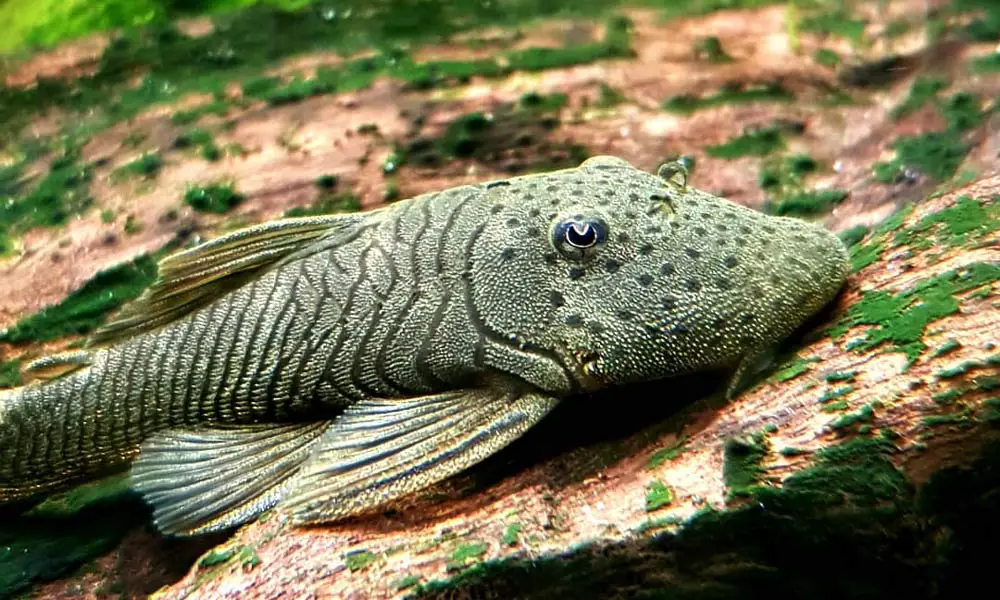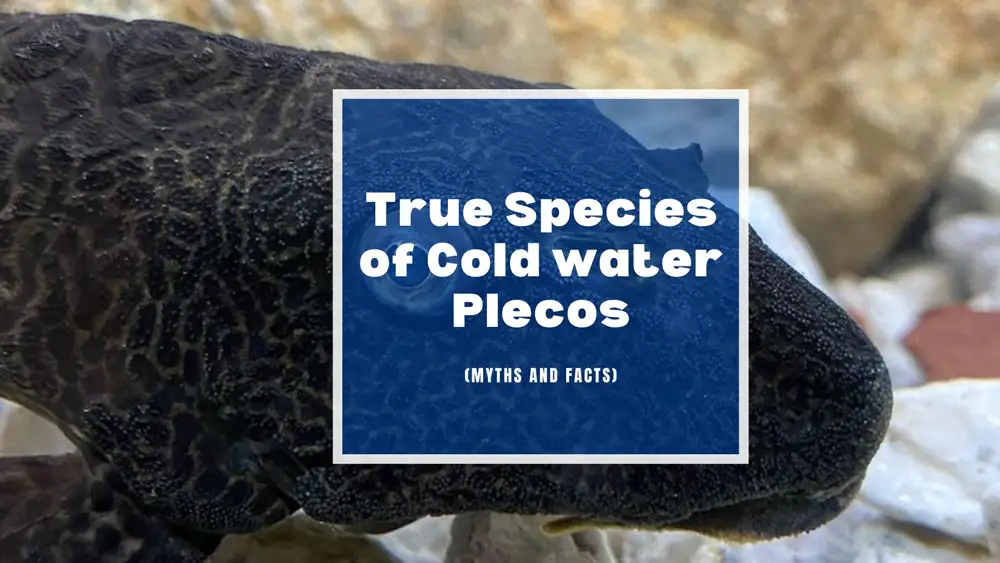Plecostomus, or “plecos,” are among the most popular freshwater catfish in the world, but there’s a lot of conflicting information about their care requirements, particularly the water parameters that make people hesitate to add one to their aquarium or pond.
Some said that plecos are fine in cold water aquariums and ponds as long as the temperature doesn’t drop below 68°F (20°C). Others claim that they need to be kept in water between 74°F (23°C) and 82°F (27.7°C), with 78°F (25.5°C) being the ideal number. So, what’s the right answer?
In this article, we will try to dispel some myths about plecos you may have heard and give you the facts about their care requirements. We’ll also cover many amazing cold water algae eaters that can get the outbreak under control in your freshwater aquariums and ponds.
Pleco Myths and Facts

Chances are if you’ve been looking for a bottom cleaner in the fish store for longer than 5 minutes, you’ve heard of plecos. A salesman may have told you that they will only grow as large as your tank (they don’t) or that they are the perfect algae eaters for your aquarium (they aren’t).
Plecos are awesome fish, but they do have some specific requirements that not every aquarium can provide. Let’s take a look at some of the most common myths and facts.
Myth #1: Common Name
The shortened form “Pleco” has been used as the common name either for a group of more than 150 similar Loricariidae species or as the name for just one species, the common pleco (Hypostomus plecostomus). The latter was one of the first Loricariids introduced in the aquarium trade.
Due to their sucker-shaped mouths and their heavy armored plates, they are often sold as “armored catfish,” “suckermouth catfish,” “sucker fish,” or even “sailfin catfish.” And beyond that, H. plecostomus has a large variety of common names, such as “janitor fish,” “crocodile fish,” “sweeper fish,” etc.
In addition, the scientific name Hypostomus plecostomus is often used to describe the common pleco sold in pet stores, but most are actually other members of the Loricariidae family.
Author note: To help sort out and identify plecostomus species, scientists have developed a system of “L” or “LDA” numbers.
Myth #2: Plecos Are Amazing Algae Eaters and Cleaners
This is the second and biggest pleco myth in the aquarium community, as well as in fish stores – the common pleco is the most marketing algae eater fish.
However, the fact is that most plecos are not good algae eaters, and they just need supplemental feedings in the form of blanched vegetables or sinking pellets/wafers. Only a small number of species are exceptions to this rule and will eat algae off your aquarium glass or even graze on it once they start to grow, such as the Bristlenose catfish(Ancistrus spp.).
For most plecos, the role of being a clean up crew too often doesn’t work out. Instead, your problem just gets worse! These messy fish will produce a lot of waste, which can quickly deteriorate water quality in your aquarium.
Myth #3: You Don’t Need to Feed the Plecos
This myth is somewhat related to the previous one, as it’s based on the assumption that plecos are good algae eaters and cleaners.
Plecos are either omnivores, herbivorous, or carnivorous by nature and in the wild. Most plecos are opportunistic feeders and will eat pretty much anything they can find, such as small crustaceans, zooplankton, insects, dead fish, fruits, and vegetables. They are also wood eaters, meaning they need some form of wood in their diet to help with their digestive process.
Some carnivorous species need a regular protein-rich diet, such as bloodworms, brine shrimp, or daphnia, to stay healthy in the long run.
NO pleco will eat fish poop. If you don’t feed them, they will starve to death. You need to research before getting a pleco to ensure you can provide them with the right diet.
Myth #4: They Will Only Grow as Large as Your Tank

When they are sold, they probably are around a few inches and look cute. You may also see them suck on the glass and eat algae. But, can you imagine the common pleco (H. plecostomus) can quickly grow up to 24 inches?
Placing these monsters in small tanks means they will not have enough space to move around and quickly outgrow their living quarters. These fish also produce a lot of waste, which can pollute the water and lead to health problems.
While some plecos stay small and are suitable for smaller aquariums, such as bristlenose plecos (Ancistrus spp.) and Otocinclus catfish (Otocinclus spp.), you still need larger tanks or a pond for these larger species.
Myth #5: They Are Peaceful Community Fish
Although most plecos are peaceful fish that do not pose any kind of threat to other fish, even these small livebearer fry depend on the species and individual fish.
For example, the clown plecos (Panaqolus maccus) and royal plecos (Panaque nigrolineatus) are peaceful fish when they are small, but as they grow larger, their temperament can change and become aggressive and territorial towards conspecifics.
Pleco Temperature

We seem to be straying from the main topic, but I think it’s important to understand that not all plecos are the same so that you can choose the right fish before purchasing one. Let’s get back on track.
When it comes to the actual water temperature that plecos can handle, it really depends on the species. Most species have the ability to withstand a wide range of water temperatures, but some display a more sensitive side.
In the wild, plecos are primarily found in various tropical waters ranging from torrential mountain rivers to calm brackish estuaries, and they are generally restricted to specific geographical regions.
Below, I listed the origin and preferred water temperature of the most popular pleco species to give you a better idea.
| Species | Temperature | Origin |
|---|---|---|
| Common pleco (H. plecostomus) | 68-82°F (20°C – 28°C) | Northeastern Brazil |
| L187B, Blonde Rubbernose Pleco (C. formosae) | 68-77°F (20.0-25.0°C) | Departamento de Boyacá, Colombia. |
| Bristlenose Pleco (Ancistrus spp.) | 73-81 °F (23°C – 27°C) | The Argentinian portion of the Paraná river drainage |
| L046, Zebra Pleco (H. zebra) | 78.8-86°F (26.0-30.0°C) | Rio Xingú, Pará State, Brazil. |
| L104, L162, or LDA22, Clown Pleco (P. maccus) | 73.4-82.4°F (23.0-28.0°C) | Río Las Marinas, trib. of Río Portuguesa, Río Orinoco basin, Estado Portuguesa, Venezuela. |
| L018, L085, L177, LDA060, Gold Nugget Pleco (B. xanthellus) | 77-86°F (25.0-30.0°C) | Senador José Porfirio, Pará, Brazil. |
| L083, Sailfin Pleco (P. gibbiceps) | 73.4-80.6°F (23.0-27.0°C) | Upper Rio Negro near Marabitanos, Amazonas State, Brazil. |
| L190, Royal Pleco (P. nigrolineatus) | 71.6-86°F (22.0-30.0°C) | Guárico River at Calabozo, Apure River drainage, Guárico State, Venezuela. |
| L102, Snowball Pleco (H. inspector) | 71.6-86°F (22.0-30.0°C) | Casiquiare, Amazonas, Venezuela. |
| Bulldog Pleco (C. milesi) | 75-80°F (24-26°C) | Honda, Colombia |
| L134, Leopard Frog Pleco (P. compta) | 75.2-82.4°F (24.0-28.0°C) | Itaituba, Pimental, Pará State, Brazil. |
| LDA004,L031, L176, L300, Peppermint Pleco (P. nudiventris) | 78.8-84.2°F (26.0-29.0°C) | Rio Xingu, bedrock at ilha do Bacabal, Pará State, Brazil. |
| L029 Vampire Pleco (L. Galaxias) | 71.6-78.8°F (22.0-26.0°C) | Rio Tocantins, Lagoa em frenta a Jacobal, Pará State, Brazil. |
| L014, Sunshine Pleco (S. aureatus) | 77-84.2°F (25.0-29.0°C) | Ilha da Fazenda, Rio Xingú, Estado Pará, Brazil. |
| Blue-Eyed Pleco (P. cochliodon) | 75-80°F (24.0-27.0°C) | Río Cauca, Magdalena River drinage, Colombia. |
| L052, Butterfly Pleco (D. picta) | 75.2-80.6°F (24.0-27.0°C) | Manaus, Brazil. |
| L025 Scarlet Cactus Pleco (P. pirarara) | 75.2-78.8°F(24.0-26.0°C) | Rio Xingu, Senador José Porfírio, Pedral do Caitucá, Brazil |
| L257, Tigris Pleco (P. tigris) | 73.4-80.6°F (23.0-27.0°C) | Backwater of Río Orinoco, Estado Amazonas, Venezuela. |
| LDA065, Titanic Pleco (P. schaeferi) | 71.6-77°F(22.0-25.0°C) | Aguaytia River drainage, Santra Ana River, Cordillera National Park |
| L059, Orange Spotted Bristlenose (A. hoplogenys) | 77-82.4°F (25.0-28.0°C) | Rio Capin, Pará State, Brazil. |
| Uruguay Bushynose (A. cirrhosus) | 70-80°F (21.0-28.0°C) | The Paraná River basin of Argentina and Uruguay. |
As you might have noticed, most plecos are native to tropical regions and prefer warm water with temperatures above 72°F(22°C). While few species come from the subtropical areas, including Uruguay, Argentina, and Rio Grande Do Sul (Brasil) may adapt to cold water with a temperature as low as the 40s.
If you’re looking for a cold water pleco, the A. cirrhosus is probably your best bet. This species is relatively adaptable when it comes to temperature. Of course, there are other origins from Uruguay, like A. taunayi and H. commersoni, but they are not as widely available in the aquarium trade.
These tropical fish are pretty hardy, but they will not survive if you leave them in your outdoor pond during the winter, even if you live in the warmest climate, like SoCal. However, several owners claimed that the common pleco could winter over in frozen ponds, but this is not something we would recommend.
To help them survive winters, you will need to bring them inside and provide them with a pond heater to maintain the water temperature.
Author note: In summer, the water temperature can rise to 86 F. (30 C.) or higher in some areas. You should cut back on lighting and increase aeration.
Algae Eaters for Ponds and Coldwater Aquarium
Most often, people looking for cold water plecos actually want an algae eater for their cold water aquarium or outdoor pond. We now know that most are omnivorous rather than algae eaters, let alone “cold water” species.
So what cold water algae eaters are available?
If you have a cold water aquarium, these are some of the best algae eaters for you:
- Reticulated Hillstream Loach (Sewellia lineolata)
- Rubber Lip Pleco (Chaetostomus sp.)
- Pepper Cory Fish (Corydoras paleatus)
- Amano Shrimp (Caridina multidentata)
- Nerite Snails (Neritina natalensis)
- Ramshorn Snail (Planorbidae sp.)
- Otos(Otocinclus arnoldi)
While for an outdoor pond, you can choose from:
- Reticulated Hillstream Loach (Sewellia lineolata)
- Chinese algae eater (Gyrinocheilus aymonieri)
- Pond loach (Misgurnus anguillicaudatus)
- Siamese Algae Eater (Crossocheilus siamensis)
- Rosy barb (Pethia conchonius)
- Common Pleco (Hypostomus plecostomus)
Conclusion
As you can see, there is not so much “cold water pleco.” Most plecos come from tropical or subtropical regions and prefer warm water. Moreover, they are not ‘amazing’ algae eaters for comparison’s sake.
So the next time you are in the pet store and look for a pleco, don’t be fooled by its cold water and algae-eating habit camouflage.
I hope that you now know more about cold water plecos and algae eaters for cold water aquariums and ponds. If you have any questions or comments, please feel free to leave them below.
Good luck!





